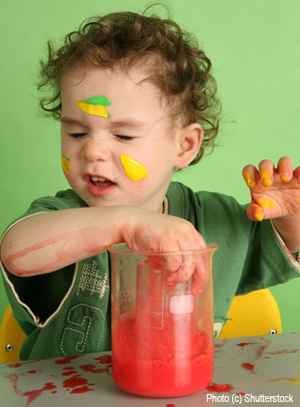The Importance of Messy Play
By Liz Parnell

Mess is an essential part of childhood. Living in a small urban homes or a rented property – as is the case for many city dwellers – can make messy play stressful and cause it to be avoided. Also, it is easy for parents to feel that people will criticize or judge if our child is seen wearing dirty clothes, or if our homes are less than pristine and spotless. Fear of bacteria can also contribute to a degree of paranoia about dirt.
When we talk about messy play, we aren’t referring to unhygienic living standards or toys strewn all over the house. We’re talking about activities such as jumping in puddles, making mud pies, painting, sand play, clay molding and play dough.
Children, especially young children, need to explore their environment with all their senses. Children learn primarily through play, so combining their need to play and their need to explore often results in a mess. This can’t be avoided and we would do well to remember that a degree of mess is part of life as a child and not something to become uptight about.
Play that incorporates rich textural experiences allows children to express their emotions through manipulating the materials (clay, paint, sand) and refines their sense of touch. The richer the textural experiences, the richer their cognitive and language development will be – how can a nine-year-old grasp the concept of “slimy” if he has never touched anything “slimy”? They also learn about cause and effect (mixing colors, pressing too hard on your play dough sculpture) as well as size, shape and many other concepts. Messy play materials should encompass different temperatures (cold, warm, tepid), textures (rough, smooth, wet, dry), scents, appearances and locations.
However, small children see no line between “play time” and the rest of life. For an infant, every waking moment is dedicated to exploring and learning. Babies and toddlers love to make food and eating a whole body experience at times, smelling, tasting, squashing and throwing their food. While it can be inconvenient to clean up, and discouraging if you have spent time lovingly cooking a meal, this food play is a normal and important part of childhood. If mess is always discouraged, a stressful relationship can develop between parent and child as well as a future avoidance of messy play (even when it is offered), which can lead to a diminished sense of touch and potentially limit cognitive development.
Messy play isn’t limited to indoor play, however. Dirt, sand, leaves and water are all great messy play materials. But what do you do when you don't have a backyard or other outdoor area to utilize? Most large cities around the world are coastal or on a major river or lake, so there are often natural waterways and beaches to explore and get messy in. National parks, state forests, fields, meadows, parks and creeks provide a range of free opportunities for play with different messy materials such as bark, sand, water, rocks, dirt, mud, shells, leaves and sticks.
There are other ways to make messy play accessible closer to home. Think of the outdoor spaces you do have access to – a courtyard, balcony, garage or shed. Is there a way you could utilize this space for messy play such as painting, even temporarily? Could you do some container gardening, or collect natural materials from around your home?
You can also make messy play less stressful inside the home. The “wet areas” of your home –typically with hard flooring and wall coverings that are resistant to water – such as kitchens, laundries and bathrooms can provide easy-to-clean opportunities for messy play. A plastic drop sheet or an old sheet underneath the child and materials can protect carpets and furniture. Confining messy play to certain areas (play dough only on the kitchen table, water only in the bathroom) can also help to make messy play a workable activity indoors. Having aprons, “play clothes” or one set of clothes that can be worn during painting, play dough and mud activities can lessen the stress that can occur when precious clothes are stained.
If you still can’t bear the thought of allowing your child to play with play dough or paints inside the house, cooking can be a great opportunity for textural play that isn’t quite so messy. Kneading dough and moulding biscuits, bread rolls or cookies can incorporate creativity and the sensory experience, but it can never replace the full experience of messy play in all its options. Take up any opportunities you can for group messy play where you don't have to worry about the clean up – such as playgroups, art classes etc.
Nothing can replace the fun and learning of a childhood filled with messy play, but children living in urban environments need not miss out on this essential group of experiences.
Liz Parnell is a wife, mother and homemaker who lives in Australia. She enjoys reading non-fiction, cooking, writing short articles, making their small living space a home and being a present mother to her children.
|
|

